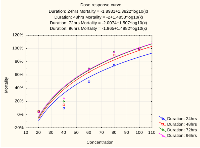The Effects of Exposure to Antibiotic Waste Water on Nile Tilapia (Oreochromis niloticus)
Keywords:
Tilapia, oxidative stress, antibiotics, acute toxicity, anaemiaAbstract
Fresh water ecosystem are frequent sinks for effluents including pharmaceutical waste water where they may be toxic to aquatic life. The aim of this study was to evaluate the acute toxicity and characterize the effect of antibiotic effluents on the morphology, haematology and activity of liver antioxidants of Oreochromis niloticus. O. niloticus fingerlings were exposed in duplicates to 20%, 40%, 60%, 80%, and 100% effluent concentrations, while juveniles with mean total length of 17 cm and mean weight of 77.89 g were exposed to sub-lethal concentrations (1/20th and 1/10th of the 96hrs LC50) for 21 days. The 24hrs, 48hrs, 72hrs and 96hrs LC50 was 59.337 (50.69 ̶ 68.79) %, 51.50 (27.19 – 74.51) %, 48.70 (41.65 – 55.49) % and 46.853 (40.04 – 53.37) % respectively. The liver weight and hepato somatic index (HSI) reduced significantly in fishes exposed to both sub-lethal concentrations compared to control (p<0.05). Red blood cell (RBC) count, packed cell volume (PCV), haemoglobin (Hb), super oxide dismutase (SOD) activity and glutathione (GSH) level decreased while malondialdehyde (MDA) level increased significantly (p<0.05) in liver of fishes exposed to 4.68% (1/10th of 96hrs LC50) and 2.34% (1/20th of 96hrs LC50). The Mean corpuscular volume (MCV), mean corpuscular haemoglobin (MCH) and mean corpuscular haemoglobin concentration (MCHC) of the exposed fishes were not different from the control (p>0.05).The study showed that antibiotic effluents was moderately toxic to O. niloticus fingerlinger. Sub-lethal concnetrations reduced liver weights, induced anaemia, reduced antioxidants activities and induced oxidative stress in liver of exposed fishes.
Downloads
References
Aebi, H.E. (1983). Catalase. In Methods of Enzymatic Analysis, 3rd ed.; Bergmeyer, H.U., Ed.; Verlag Chemie: Weinheim, FL, USA; 273–
APHA (1985). Standard methods for the examination of water and wastewater, 16th edition. American Public Health Association, Washington DC, Page 800-819
Anyakora C., Nwaeze K., Awodele O., Nwadike, Arbabi, M., and Coker, H. (2011). Concentrations of heavy metals in some pharmaceutical effluents in Lagos, Nigeria. Journal of Environmental Chemistry and Ecotoxicology, 3(2), 25-31.
Blair B.D., Crago J.P., Hedman C.J., and Klaper R.D, (2013). Pharmaceuticals and personal care products found in the Great Lakes above concentrations of environmental concern, Chemosphere, 93, (9), 2116-2123, https://doi.org/10.1016/j.chemosphere.2013.07.057
Boxall A.B.A, et al. (2012). Pharmaceuticals and personal care products in the environment: what are the big questions? Environ. Health Perspect. 120, 1221–1229. doi:10.1289/ehp.1104477
Brodin T., Piovano S., Fick J., Klaminder J., Heynen M., and Jonsson M. (2014). Ecological effects of pharmaceuticals in aquatic systems –
impacts through behavioural alterations, Philos. Trans. R. Soc. Lond. B 369(1656): 20130580.
Buřič M., Grabicová. K., Kubec J., Kouba A., Kuklina I., Kozák P., Grabic R., and Randák T. (2018). Environmentally relevant concentrations of tramadol and citalopram alter behaviour of an aquatic invertebrate. Aquatic Toxicology. 200. 226-232. 10.1016/j.aquatox.2018.05.008.
Burkina, V., Fedorova, G., Grabicova, K., Grabic, R., Golovko, O., Randak, T., Sakalli, S., and Zlabek, V., (2014). Clotrimazole in rainbow trout I:
distribution, bioaccumulation, depuration and response of cytochrome system after long-term exposure phd
Cardoso O., Porcher J.M., and Sanchez W (2014) Factory-discharged pharmaceuticals could be a relevant source of aquatic environment contamination: review of evidence and need for knowledge,Chemosphere 115, 20–30.
Dacie J.V, and Lewis S.M. (2001). Practical hematology. 9th edition, New York: Churchill Livingstone, 633
Du, B., Haddad, S. P., Luek, A., Scott, W. C., Saari, G. N., Kristofco, L. A., Brooks, B. W. (2014). Bioaccumulation and trophic dilution
of human pharmaceuticals across trophic positions of an effluentdependent wadeable stream. Philosophical Transactions of the
Royal Society B: Biological Sciences, 369(1656), 20140058. http://doi.org/10.1098/rstb.2014.0058
El-Sayed Y.S., Saad T.T., and El-Bahr S.M. (2007). Acute intoxication of deltamethrin in monosex Nile tilapia, Oreochromis niloticus with special reference to the clinical, biochemical and haematological effects. Environ Toxicol Pharmacol 24:212–217
Finney, D. J., Ed. (1952). Probit Analysis. Cambridge, England, Cambridge University Press.
Fram M.S., and Belitz K. (2011).Occurrence and concentrations of pharmaceutical compounds in groundwater used for public drinking-water supply in California. Science of The Total Environment, 409, (18), 3409-3417. https://doi.org/10.1016/j.scitotenv.2011.05.053.
Heberer T (2002). Occurrence, fate, and removal of pharmaceutical residues in the aquatic environment: a review of recent research data, Toxicol. Lett. 131; 5-17.
Jollow, D.J., Michell, J.R., Zampaglione, N. and Gillete, J.R. (1974).Bromoibenzene induced Liver necrosis: Protective role of glutathione and evidence for 3,4-Bromobenzene oxide as hepatotoxic metabolite. Pharmacology,11, 151–169.
Kanu, K.C., Ijioma, S.N., and Atiata, O. (2016). Haematological, Biochemical and Antioxidant Changes in Wistar Rats Exposed to Dichlorvos Based Insecticide Formulation Used in Southeast Nigeria. Toxics, 4, 28.
Kaplowitz, N. (1981). The importance and regulation of hepatic glutathione. The Yale Journal of Biology and Medicine, 54(6), 497–502.
Kasagala K.H.D.T., and Pathiratne A. (2008). Effects of waterborne chloramphenicol and oxytetracyclene exposure on hematological parameters and phagocytic activity in the blood of Koi carp. Cyprinus carpio. In: Bondad-Reantaso MG, Mohan CV, Crumlish M, Subasinghe
RP, eds. Diseases in asian aquaculture VI. Fish health section. Malina, Philippines: Asian Fisheries Society, 283–296.
Kreutzmann H.L. (1977). The effects of chloramphenicol and oxytetracycline on hematopoiesis in the European eel
(Anguilla anguilla). Aquaculture 10:323–334
Lahti M., Brozinski J.M. Jylhä A. Kronberg L., and Oikari A(2011), Uptake from water, biotransformation, and biliary excretion of pharmaceuticals by rainbow trout, Environ. Toxicol. Chem. 30(6): 1403–1411.
Li, Z.H., Velisek, J., Zlabek, V., Grabic, R., Machova, J., Kolarova, J., Li, P., and Randak, T. (2011). Chronic toxicity of verapamil on juvenile rainbow trout (Oncorhynchus mykiss): Effects on morphological indices, hematological parameters and
antioxidant responses. Journal of Hazardous Materials 185, 870–880
Liu, J., Lu, G., Zhang, Z., Bao, Y., Liu, F., Wu, D., Wang Y. (2015). Biological effects and bioaccumulation of pharmaceutically active compounds in crucian carp caged near the outfall of a sewage treatment plant. Environ. Sci.: Processes Impacts, 17, 54-61
Li, Z. H., Zlabek,V.,Velisek, J., Grabic, R., Machova, J. and Randak, T (2010). Physiological condition status and muscle-based biomarkers in rainbowtrout (Oncorhynchus mykiss), after long-term exposure to carbamazepine. J.Appl.Toxicol. 30,197–203.
Lushchak, V.I. (2011). Environmentally induced oxidative stress in aquatic animals. Aquatic Toxicology 101, 13–30.
Magwere T., Naik Y.S., Hasler J.A. (1997). Effect of chloroquine treatment on antioxidant enzymes in rat liver and kidney. Free Radic. Biol. Med. 22: 321–327.
Mello, T., Zanieri, F., Ceni, E., & Galli, A. (2016). Oxidative Stress in the Healthy and Wounded Hepatocyte: A Cellular Organelles Perspective. Oxidative Medicine and Cellular Longevity, 2016, 8327410. http://doi.org/10.1155/2016/8327410
Musson S.E., and Townsend T.G. (2009). Pharmaceutical compound content of municipal solid waste, J. Hazard. Mater. 162 (2009) 730-735
NESREA (2009). National Environmental Standards and Regulation Enforcement Agency (NESREA) Regulations. Volume 96, Number 65,
The Federal Government Printer, Abuja, Nigeria.
Nunes, B., Antunes, S.C., Gomes, R. Campos J. C., Braga M. R., Ramos A. S., and Correia A. T. (2014). Acute
Effects of Tetracycline Exposure in the Freshwater Fish Gambusia holbrooki: Antioxidant Effects, Neurotoxicity and Histological
Alterations Arch Environ Contam Toxicol (2015) 68: 371. https://doi.org/10.1007/s00244-014-0101-z
Nwani C.D., Mkpadobi B.N., Onyishi G, Echi P.C., Chukwuka C.O, Oluah S.N, and Ivoke N (2015). Changes in behavior and hematological parameters of freshwater African catfish Clarias gariepinus (Burchell 1822) following sublethal exposure to chloramphenicol. Drug and chemical toxicology, DOI: 10.3109/01480545.2013.834348
Pamplona J.H., Oba E.T., da Silva T.A., Ramos L.P., Ramsdorf W.A., Cestari M.M., Oliveira Ribeiro C.A., Zampronio A.R., and Silva de Assis H.C. (2011). Subchronic effects of dipyrone on the fish species Rhamdia quelen, Ecotoxicology and Environmental Safety, 74, 3,342-349. Pavarino EC, Russo A, Galbiatti ALS, Almeida WP, dan Bertollo EMG, 2013. Glutathione: Biosynthesis and Mechanism of Action, Nova Science Publishers, Inc, Newyork: 1-31. Available at https://www.novapublishers.com/catalog/downloadOA.php?order=1&access=true
Petrovic, M.,Susana G., and Damia B. (2003). Analysis and Removal of Emerging Contaminants in Wastewater and Drinking Water.
Trends in Analytical Chemistry. 22. 685-696. 10.1016/S0165-9936(03)01105-1.
Ramirez AJ, Brain RA, Usenko S, Mottaleb MA, O’Donnell JG, Stahl LL, et al. (2009). Occurrence of pharmaceuticals and personal care products (PPCPs) in fish tissues: results of a national pilot study in the United States. Environ Toxicol Chem 28:2587–2597
Ramola B, and Singh A (2013). Heavy Metal Concentrations in Pharmaceutical Effluents of Industrial Area of Dehradun (Uttarakhand), India. J Environ Anal Toxicol 3: 173. doi: 10.4172/2161-0525.1000173
Rzymski, P., Agnieszka D., and Klimaszyk, K. (2017). Pharmaceutical pollution of aquatic environment: an emerging and enormous challenge. Limnological Review. 17. 97-107. 10.1515/limre-2017-0010.
Steinbach, C., Burkina, V., Fedorova, G., Grabicova, K., Stara, A., Velisek, J., Zlabek, V., Schmidt-Posthaus, H., Grabic, R., and Kocour Kroupova, H (2014). The sub-lethal effects and bioconcentration of the human pharmaceutical atenolol in rainbow trout (Oncorhynchus mykiss).
Science of the Total Environment. 497–498: 209–218.
Sui, Q., Cao X., Lu S., Zhao, W., Qiu Z., and Yu, G (2015). Occurrence, sources and fate of pharmaceuticals and personal care products in the groundwater: A review. Emerging Contaminants 1, 14-24.
Wallin B, Kosengreen B, Shertzer HG, and Camejo G (1993). Lipoprotein oxidation and measurement of TBARS formation in a single microliter plate; Its use for evaluation of antioxidants. J. Anal. Biochem. 208:10-15.
Wu P and Shen H (2018) IOP Conf. Ser.: Earth Environ. Sci. 113 012142http://iopscience.iop.org/article/10.1088/1755-1315/113/1/012142/pdf
Xie W and Shen H (2017) IOP Conf. Ser.: Earth Environ. Sci. 100 012162 http://iopscience.iop.org/article/10.1088/1755-1315/100/1/012162/pdf
Yamamoto, H., Nakamura, Y., Moriguchi, S., Honda, Y., Tamura, I., Hirata, Y., Hayashi, A., and Sekizawa, J (2009). Persistence and partitioning of eight selected pharmaceuticals in the aquatic environment: laboratory photolysis, biodegradation, and sorption experiments. Water Res. 43, 351–362
Yonar E.M., Yonar M.S., and Silici S. (2011). Protective effect of propolis against oxidative stress and immunosuppression induced by oxytetracycline in rainbow trout (Oncorhynchus mykiss, W). Fish Shellfish Immunol 31:318–325

Downloads
Published
Issue
Section
License

This work is licensed under a Creative Commons Attribution-NonCommercial-ShareAlike 4.0 International License.







